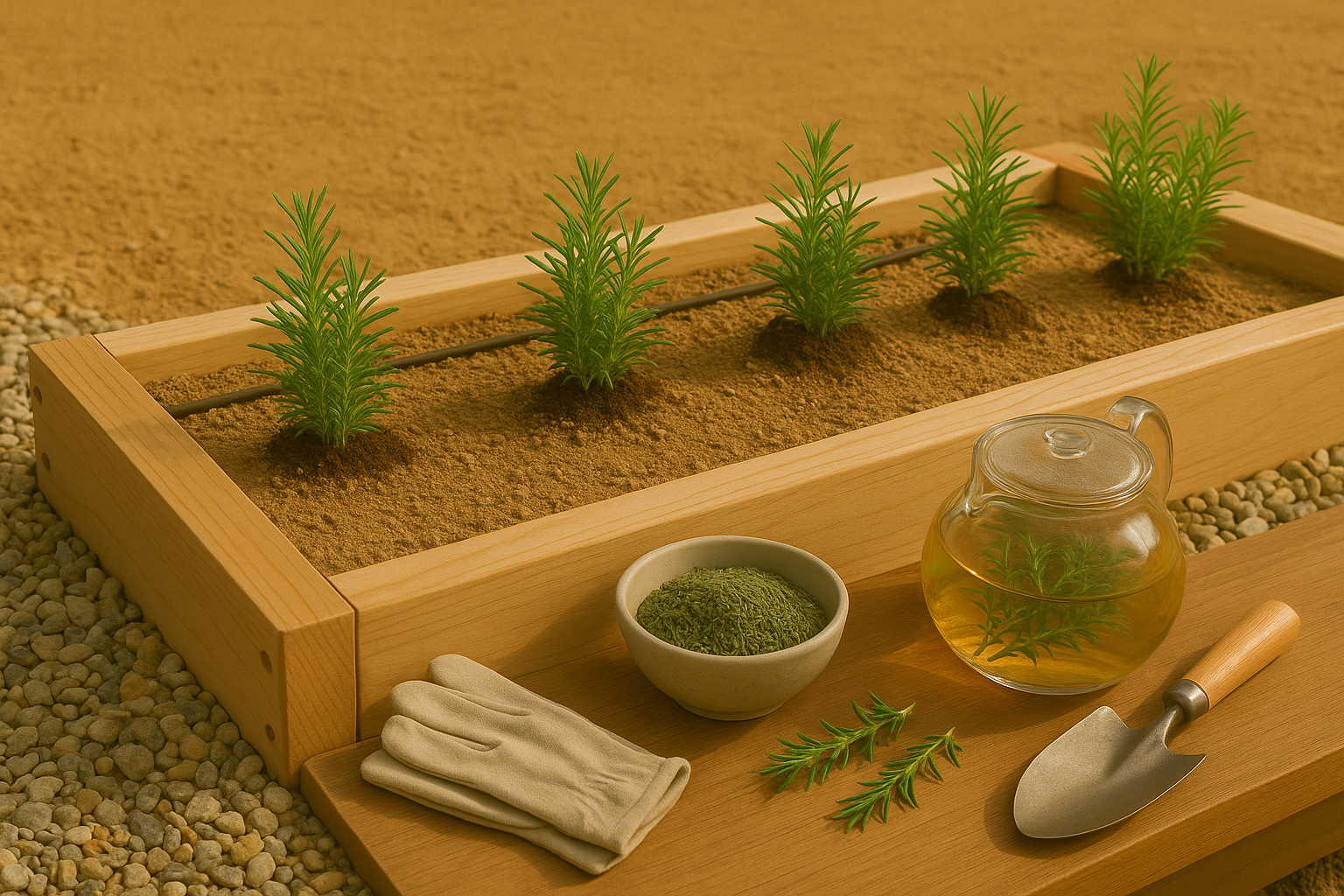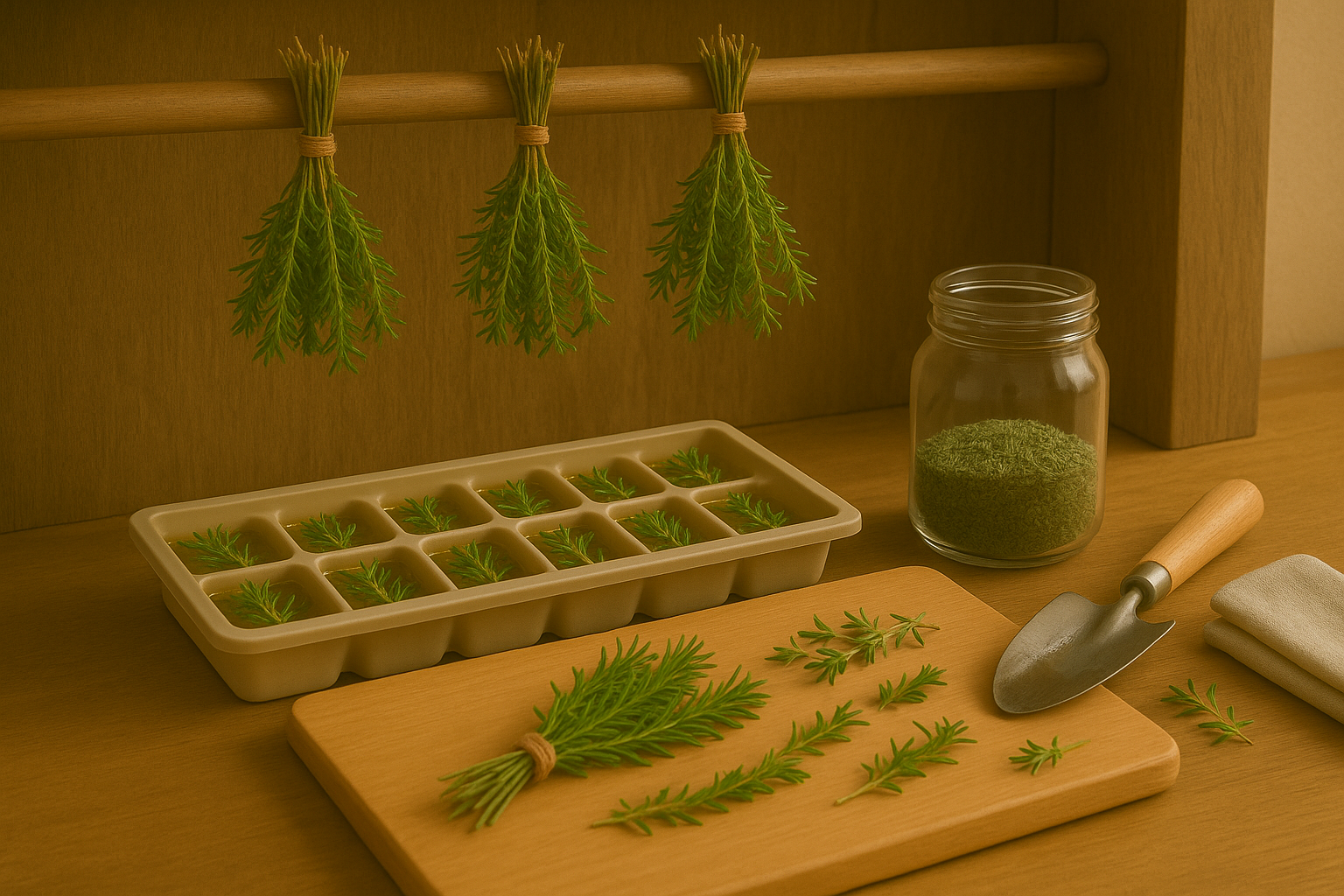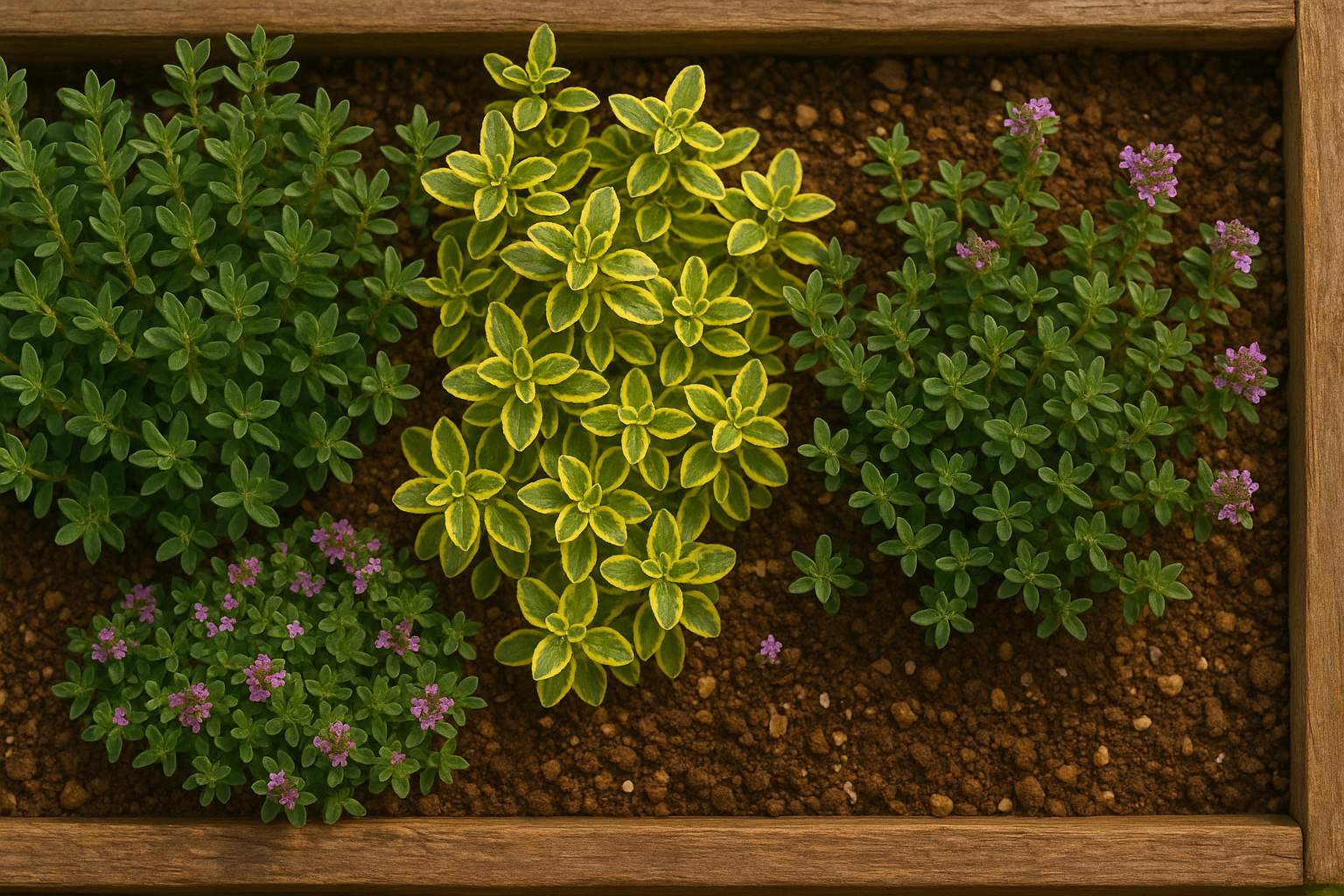Best Thyme Varieties to Grow at Home
Thyme is a fragrant, resilient herb that’s remarkably easy to grow at home, making it a staple for both novice gardeners and seasoned green thumbs. With over fifty species to explore, the options for culinary adventure and garden beauty are extensive.
The most popular choice is Common Thyme (Thymus vulgaris), cherished for its classic earthy-lemon aroma and versatility in the kitchen; it thrives in well-drained soil, full sun, and can transition smoothly from garden bed to windowsill pot. For a subtler, citrusy kick in teas and desserts, Lemon Thyme (Thymus citriodorus) is a favorite—distinguished by small, bright green or variegated yellow-edged leaves. This variety is hardy and spreads nicely as ground cover or in container gardens, plus its fresh sprigs brighten up fish, chicken, and vegetable dishes beautifully.
For gardeners craving low-maintenance beauty, Creeping Thyme (Thymus serpyllum) delivers delicate, purple-pink blooms that attract pollinators and provide a fragrant, walkable lawn alternative. It tolerates light foot traffic and is drought resistant, making it a standout for eco-friendly yards.
Unique Thyme Varieties to Try
If you want to branch out beyond the basics, consider experimenting with varieties like Caraway Thyme (Thymus herba-barona), whose spicy, caraway-scented leaves add complexity to bread, roasted meats, and potato dishes. Woolly Thyme (Thymus pseudolanuginosus) is another appealing choice, known for its silvery, fuzzy foliage and mat-forming habit. While not ideal for heavy culinary use, it excels at filling gaps between stepping stones and cascading over rock walls.
Orange Balsam Thyme (Thymus x citriodorus ‘Orange’) adds a sweet, orangey twist to herb blends and pairs well in marinades or salad dressings. For something truly unique, try Silver-Edged Thyme (Thymus ‘Silver Posie’), which brings ornamental flair with its pale-edged leaves while still delivering that classic thyme flavor perfect for soups, stews, and roasts. These ornamental varieties thrive under similar conditions as common thyme: plenty of sun, well-drained or sandy soil, and moderate watering, especially once established.
Planting and Growing Tips

Whether you’re just starting or refining an established herb plot, success with thyme begins with proper site selection. Choose a location with six or more hours of sun daily—even a sunny windowsill works if outdoor space is limited. Thyme prefers soil that drains well; heavy clay or waterlogged areas can cause root rot. If your soil needs better drainage, mix in some sand or fine gravel. Avoid over-fertilizing—thyme thrives in lean soils and actually becomes more fragrant when slightly stressed.
Plant thyme seedlings or cuttings about 12–18 inches apart, and consider mulching lightly with gravel to reduce weeds and reflect warmth back to the plants. Indoors, place pots near bright windows and use containers with drainage holes to prevent soggy roots. Water thyme only when the top inch of soil feels dry; overwatering is a common mistake that quickly harms the plant.
Maintenance and Harvesting
Pruning is essential for keeping thyme lush and productive, especially since it can get woody with age. Shear back the top third of the stems just as flowering begins in late spring or early summer to encourage fresh, tender growth. Regular harvesting doubles as gentle pruning—just snip a few sprigs as needed, which promotes branching and bushier plants.
In cooler climates, mulch outdoor plants with straw or leaves to help them overwinter, or bring potted thyme indoors before the first frost. Dividing thyme every three to four years revitalizes older plants and provides new starts for expanding your herb garden or sharing with friends.
Using Thyme in the Kitchen and Beyond
Using thyme is as easy as clipping and rinsing a few sprigs. Common and lemon thyme are must-haves for seasoning soups, roasted vegetables, meats, and bread doughs. Lemon thyme shines in salad dressings, herb butters, and stewed fruit compotes. Caraway thyme’s unique flavor breathes new life into rye bread, while orange balsam thyme’s fruity essence pairs beautifully with desserts and herbal teas.
Both fresh and dried thyme retain their flavor well, though drying concentrates the aroma. Simply tie stems into small bundles and hang them upside down in a warm, airy spot. You can also freeze thyme leaves in ice cube trays with olive oil or water for easy use in winter stews and sautés. For a fragrant household touch, tuck small sachets of woolly thyme leaves into drawers or place pots of blooming creeping thyme on sunny patios to add beauty and support pollinators.
Thyme is a remarkably giving herb—it’s beautiful, edible, and largely trouble-free once established. Focus on sun, drainage, and avoiding overwatering, and you’ll enjoy hardy plants ready to flavor your meals and brighten your garden for seasons to come. Start with a reliable favorite, then add one or two unique varieties each year to discover your favorite flavors. Whether you’re crafting an herbal tea haven, planting pollinator-friendly groundcover, or just want fresh sprigs by your kitchen sink, thyme’s versatility and charm promise satisfaction for gardeners of every experience level. Don’t hesitate to experiment—thyme’s forgiving nature almost always guarantees a rewarding harvest, a fragrant landscape, and plenty of inspiration for next season’s plantings.
Why Grow Thyme at Home?
Thyme is a wonderfully versatile and aromatic herb that adds a burst of fresh flavor to countless dishes, from roasted vegetables to homemade marinades. For home gardeners and cooks, thyme’s value goes beyond the kitchen—it’s also prized for its pretty, low-growing foliage and delicate flowers that attract pollinators.
One of thyme’s biggest appeals is how easy it is to grow; it thrives even if you don’t have a green thumb. With minimal watering needs and no fussy requirements, thyme fits effortlessly into both busy schedules and novice gardens. Whether you have a sunny windowsill, a small balcony, or a spacious backyard, thyme adapts well to pots, containers, or traditional garden beds. This makes it perfect for apartment dwellers and homeowners alike.
By growing thyme at home, you’ll always have a fresh supply on hand and can enjoy its scent and beauty all season long.
Most Popular Culinary Thyme Varieties
When it comes to culinary thyme, Common Thyme (Thymus vulgaris) stands out as the classic choice found in most kitchens. Its earthy, robust, and slightly minty flavor makes it a staple in soups, roasted vegetables, and meat dishes. Lemon Thyme (Thymus citriodorus) offers a refreshingly bright, citrusy twist—perfect for seafood, salads, and even desserts, thanks to its subtle lemon aroma. Silver Thyme boasts variegated leaves with a milder, almost floral taste, making it ideal for more delicate recipes where you don’t want to overpower other ingredients. French Thyme, often favored by chefs, features a sweeter, softer flavor and finer leaves, making it popular in refined French cuisine. Each variety brings a unique note to dishes, offering versatility across savory and even some sweet applications.
Best Culinary Pairings for Each Variety
- Common Thyme: Roasted chicken, stews, root vegetables
- Lemon Thyme: Fish, shrimp, vinaigrettes, fruit salads
- Silver Thyme: Light poultry dishes, egg-based recipes, soups
- French Thyme: Sauces (like béarnaise or velouté), lamb, ratatouille
Unique and Ornamental Thyme Varieties
When it comes to adding both charm and function to your garden, unique thyme varieties like Creeping Thyme, Golden Thyme, and Woolly Thyme are fantastic options.
Creeping Thyme forms dense, fragrant mats of tiny pink or purple blooms, making it a colorful ground cover that feels soft underfoot and can even fill gaps in stepping stones. Golden Thyme catches the eye with its bright yellow-edged leaves, adding a pop of color to borders or rock gardens while releasing a subtle, lemony aroma when brushed. Woolly Thyme boasts silvery, fuzzy foliage that thrives in poor soil and spills beautifully over edges and stones, bringing a whimsical texture to your landscape.
Besides their ornamental beauty, these thymes attract bees and butterflies, promoting a healthy ecosystem. Use them to replace lawns in small areas, outline garden beds, or create living pathways, and enjoy an aromatic, pollinator-friendly outdoor space.
Tips for Growing Healthy Thyme
Thyme thrives with at least six hours of direct sunlight each day, so choose a sunny spot—whether that’s in your herb garden or on a bright windowsill. This hardy herb prefers well-draining, slightly alkaline soil; you can improve drainage by mixing in sand or gritty compost, especially if you’re growing thyme in clay-rich soils.
Water sparingly: let the top inch of soil dry out before watering again, as thyme is drought-tolerant and struggles in soggy conditions. If you’re deciding between a container or in-ground bed, keep in mind that container planting gives greater control over soil and moisture—perfect for creeping or lemon thyme, which like to spread but need good drainage.
Meanwhile, hardy English and common thyme do well directly in garden beds, but watch for overcrowding. Regular pruning is key: after flowering, trim back woody stems to promote bushy, healthy growth. During harvests, snip sprigs from the outer edges and avoid cutting more than a third of the plant at a time. This not only encourages new shoots but also extends the plant’s productive life.
With a bit of attention to its preferred conditions, thyme can deliver fragrant, flavorful leaves almost year-round.
Common Thyme Care Challenges (and How to Avoid Them)
Caring for common thyme can be tricky if you don’t watch for a few pitfalls. Overwatering is the biggest culprit, often causing yellow leaves or mushy stems. Always let the soil dry out between waterings and use a pot with drainage holes.
Poor drainage leads to root rot, so plant thyme in sandy, well-draining soil. If you notice wilting or a musty smell, repot it with a gritty mix.
Pest issues like spider mites or aphids may pop up, showing as sticky residue or tiny webbing on the leaves. Rinse plants gently with water or use insecticidal soap at the first sign of trouble.
Watch for woody stems and sparse growth—these are signs your thyme needs pruning. Regularly trim back overgrown parts to encourage fresh shoots.
A stressed thyme plant often looks dull, leggy, or has spotted leaves. Adjust watering, improve lighting, or check for pests to bring it back to health quickly.
Best Ways to Use and Store Your Homegrown Thyme

Harvest thyme just before it flowers for the best flavor—early morning is ideal when the oils are most concentrated. Snip leafy stems and use them fresh in cooking, sprinkle over roasted vegetables, or infuse in soups and teas.
To preserve thyme, hang bunches in a well-ventilated area away from sunlight, or use a dehydrator for quicker drying. Store dry leaves in airtight jars for months of use.
Thyme pairs wonderfully with rosemary, sage, or oregano, so consider growing these companions together to maximize your herb garden’s yield and bring fresh, fragrant flavor to your kitchen all year long.
FAQs About Growing Thyme at Home
Many gardeners wonder which thyme variety to choose—common thyme is versatile for cooking, while lemon thyme offers a citrus twist. Thyme grows well both indoors and outdoors; just place your indoor pot in a sunny window, as this herb loves bright light.
Watering is simple: let the soil dry out between waterings, since thyme prefers slightly dry conditions and dislikes soggy roots. A common myth is that thyme needs constant attention, but it’s actually quite hardy and low-maintenance.
Avoid overwatering or overfeeding, and you’ll find thyme thrives with a light touch, offering fresh sprigs for your kitchen year-round.
